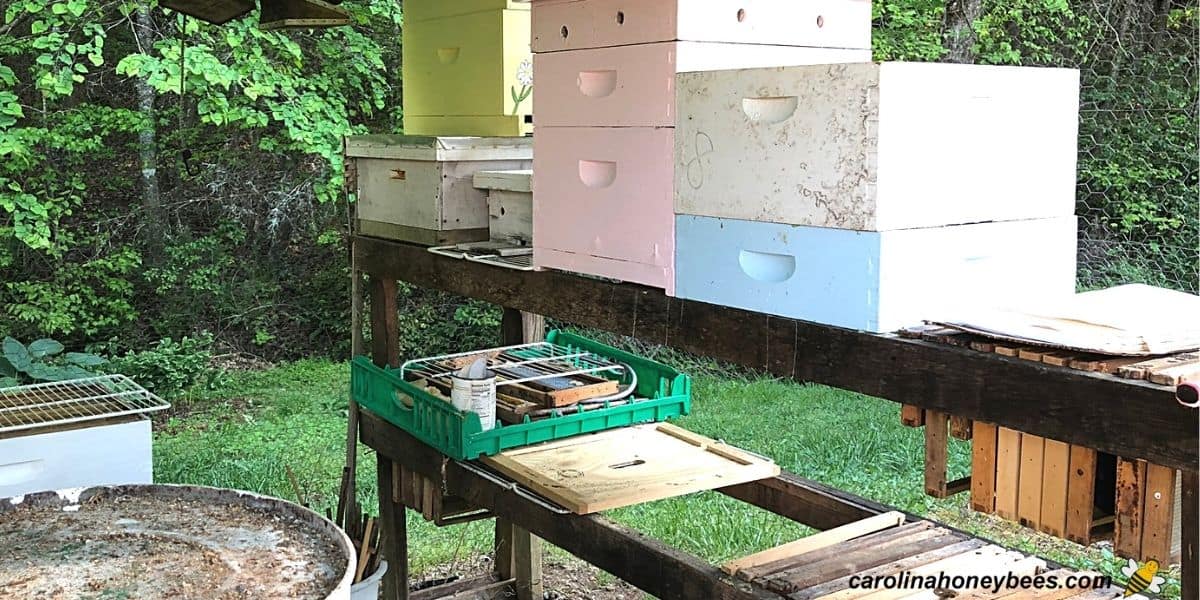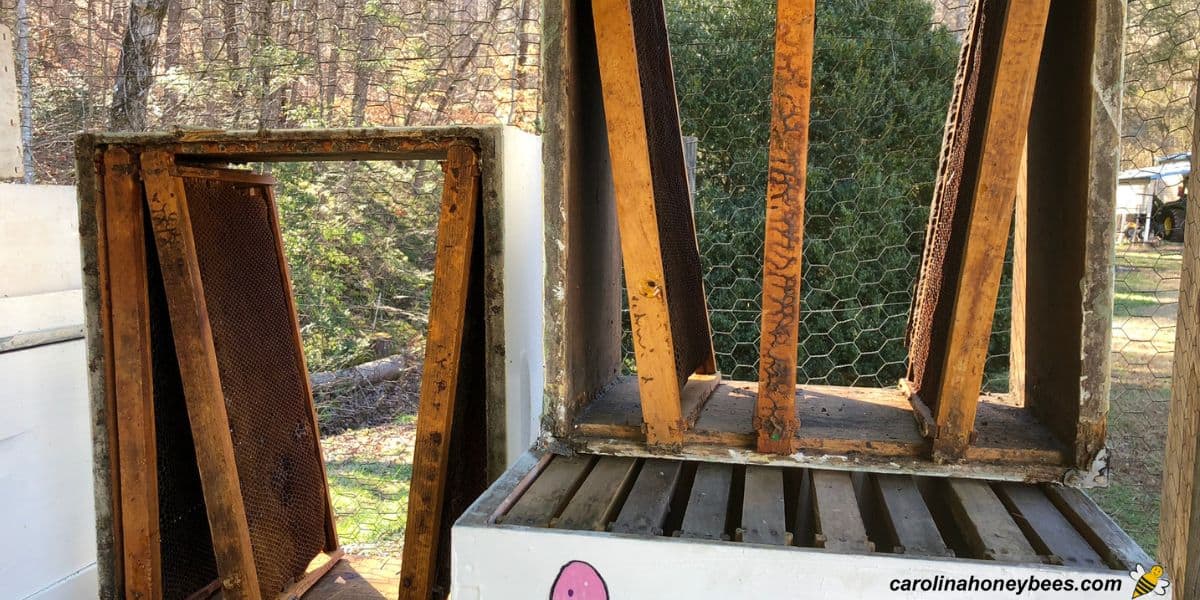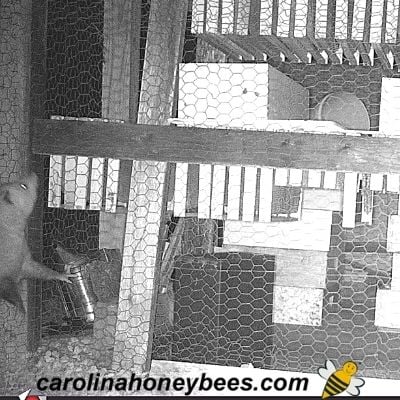Winter Storage of Beekeeping Equipment
As the end of the season approaches, it is time to consider how to store your beekeeping equipment over Winter. Whether we are considering wooden ware, tools or clothing – each has some special storage considerations. This guide offers practical tips for safely storing your beekeeping gear, with a focus on protecting your investment. I will also give you a look at my beekeeper’s shed that is ugly but gets the job done well.

I have been a beekeeper for a while, and I can say your inventory of “needed things” will tend to grow over the years. Finding a good storage system for various beekeeping equipment & tools is often over-looked until you can’t walk through your garage.
Storing Beekeeping Items for Winter
Of course, it is not only in Winter that equipment storage is an issue. Most beekeepers know the importance of having some extra honey box or supers on hand during the season.
As colony population grows and wanes, colonies swarm, you split some beehives, you will find yourself needing at least a temporary place to store some extras.

But, it is the long winter months – when beekeeping is not on your radar that requires the most thought to protect your gear and have it ready for Spring. And, the more hives you manage – the more space you will need for the extra wooden components, feeders, etc.
Wooden Hive Component Storage
It is the wooden parts of the beehive that will take up the most space. Empty hive bodies (without comb), honey supers, top, bottoms and more.
Personally, I like to stack hive components tightly (with a board on the bottom and top of the stack) to keep the local mice out of them too.
All should be scraped clean of excess wax and bee propolis – if they have been used. Then, empty boxes can be stacked anywhere they will be protected from weather.
Special Storage for Boxes with Comb
Many beekeepers extract the honey crop by machine leaving valuable wax in the frames for the bees to reuse. We call these frames of – “drawn comb”.
Giving a colony a box of drawn comb rather than just beehive foundation is very helpful to a new hive. A lot of energy (food) is required for bees to produce wax and make comb.
You can not just stack these up just anywhere. They must be protected from wax moths and other pests. This requires special attention and is not simply a case of keeping moths out.
If you have frames/boxes with comb – go over to my guide on how to store honey supers properly. It covers the basics of protecting wax comb – whether in a honey super or deep box.
Freezing Bee Supplies
You might look in my freezer and see some beekeeping supplies from last year, or the year before, or the year before etc. Actually a freezer is a very useful tool for a beekeeper.
In mine, you may see a bag of leftover buckwheat seed. I plant a small plot of buckwheat for my bees most years. It will bloom in 30 days and provide natural forage for the bees in a time that is usually very dry.
The freezer is a great place to store left over bee pollen substitute too! Seal it in a sturdy bag and the freezer helps to keep it fresh. It will be all ready for making pollen patties or using in your dry pollen feeder next Spring.

Freezing Extra Honey Frames for Later
Another great use of the freezer, is storing frames of honey. These partial frames of honey are safely frozen and will be given to hungry colonies in late winter or as part of Spring beekeeping chores.
Freezing keeps the honey fresh and protected from wax moths and hive beetle eggs. The frames will be removed from the freezer and allowed to thaw the day before being placed in the hive.
This is also a good way to store honey for human consumption at a later time. Once thawed, you will never know it has been frozen.
Storing Beekeeping Suits and Veils Safely
Clean or wash your beekeeping suit at the end of the season – at least once a year. Yes, you do need to wash it – even if it doesn’t seem to help.
This removes some of the dirt, sweat and stinger bee pheromones that may be there. But sure it is completely dry before packing it away. Folded damp suits may mildew over Winter.
And more than one beekeeper has lost an expensive beekeeping suit to a mouse looking for a home!
If you have a dedicated pair of shoes used for beekeeping – make sure they are clean and stored in an easily accessible location.
Beekeeper’s Tool Box for Small Stuff
For storing odds and ends (over winter or taking them to the bee yard). I often use a little plastic household tote.
A 5 gallon bucket perhaps with one of those organizers on the outside is useful. Your smoker (once cool) and smoker fuel can go inside.
Keeping a beekeepers bucket, tool box or tote ready to go will be a big help. In this way, you don’t have to remember every little thing each time you go out to do hive inspections.
I always keep the basic beekeeping tools in my tote. I need my favorite hive tool to use, spray bottle with sugar water, queen marking pen, smoker fuel, matches, etc.
And, during the off season, that little container is easily out of the way in a closet or on a workroom shelf. If you decide to get a tote, make sure it will hold your plastic spray bottle without falling out.
Of course, there are also some fancy models you can find for sale from various supply stores – they work well too.
And, at the end of the season or the beginning of the next, don’t forget to clean your bee smoker. It may only need a good brushing out – but if you have used it a lot – a deep clean may be necessary.

My Beekeeper’s Shed for Storage – It Ain’t Pretty
It is not something you must have. But, a beekeeper’s shed is a wonderful answer to the problem of storing beekeeping equipment. And, yours does not have to be as ugly as mine.
A simple open shed has many advantages. The roof protects the wooden wear from rain and snow (for the most part).
It is a convenient place to keep my bee smoker. With the cement floor – I can even sit it down while it is still hot without worry.
The open airy shed helps protect my supers of drawn comb – because wax moths love dark places-not open light ones. I also be sure to use Certan as a wax moth preventative on frames stored here.
This post may contain affiliate links. As an Amazon Associate, I earn from qualifying purchases. Please read my disclosure.
I prefer using Certan B402 for wax moth protection of stored drawn comb. There is no strong smell and it is a natural product.
I can stack empty honey supers or those with comb crisscross or hang the frames on wooden rails or a custom made frame rack.
Originally, my shed looked prettier and did not have wire around the side. However, the rascally raccoons damaged several frames of drawn comb one winter. Even the opossums wanted to get in on the fun.
Therefore, I sacrificed beauty for function. Surround your shed with wire or something to keep raccoons and out. Remember: let light in – keep animals and weather out.
It’s a great help for me and a convenient place to throw equipment when you come in from the bee yard all hot and tired. You do have to go back later and restack it of course.

Finally
No matter how much you try to limit your beekeeping passion to one area of the house or yard, it will certainly spill over. There are as many ways to store beekeeping equipment as there are beekeepers. Find something that works for you and your bees.



